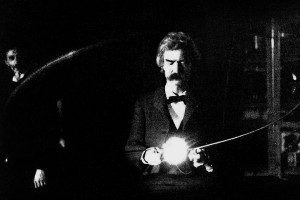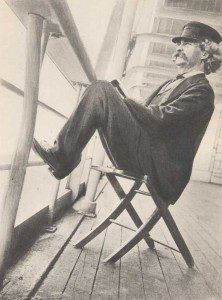
Mark Twain was a lifelong student of meaningful coincidence. In 1878, he gathered some of experiences and experiments in a most interesting article he titled “Mental Telegraphy.” He waited 20 years to publish it, fearing ridicule or incredulity. When public interest and scientific research (notably the investigations of the young Society for Psychical Research in England) began to catch up with his own findings, he published the article in Harper’s Magazine.
I once made a great discovery: the discovery that certain sorts of things which, from the beginning of the world, had always been regarded as merely “curious coincidences” – that is to say, accidents – were no more accidental than is the sending and receiving of a telegram an accident.
One of his favorite examples of the interplay of psyche and physics that generates coincidence is the phenomenon of “crossed letters.” You know the kind of thing: you write to someone (or just think about them) – maybe someone you have not been in contact with for months – and then you get a letter or a call from them the same day, or very soon after.
Mark Twain noticed that again and again, when he wrote to someone, he would get a letter from that person that was mailed at or around the same time. He concluded that this was very often the effect of distant communication between minds keyed to similar wavelengths. One example is The Great Bonanza book.
One afternoon, Mark Twain was seized with the passionate conviction that a great book could be written about the silver bonanza in Nevada. He felt his old newspaper colleague Wright would be the man to do it, but Twain was so possessed by the idea that he immediately roughed out an outline and sample chapters to get his old friend started. He was preparing to mail all this material to Wright when he received a package in the mail. Before opening the package, Twain told the people with him that he was going to deliver a “prophecy”; he declared that the package contained a letter from his old friend Wright, with his drafts for a book on the Great Bonanza. And so it did.
This incident convinced Twain not only that mental telegraphy is real, but that it can be strong enough to transport the complete content of a book across 3,000 miles. Fortunately, Twain and Wright were good friends and Twain had already determined that the Great Bonanza book was to be done by Wright; otherwise, the mental transfer (from Wright to Twain) could have resulted in two books and charges of plagiarism.
Minds resonate with each other, and in doing this transfer ideas and messages, back and forth. Twain was very interested in determining whether we can pluck the strings as well as wait for them to vibrate.
A case in point – from Twain’s chronicle – involved an American on the Grand Tour in Europe who was desperate since he had received no news from his son, back in San Francisco, in many months, despite sending many letters. Twain urged him to send a cable, which might sound like merest common sense. Here’s the uncommon sense: Twain further told the worried father that it did not matter where he sent the cable. “Send it to Peking, if you like.” All that mattered was that he should send a cable, and thereby send out a signal to the universe. . If he did that, Twain promised, he would have news from his son right away. The father sent the cable and the next day received a letter from his son explaining that he had left San Francisco months before on a slow boat and was now acting on his first opportunity to post a letter. The cable did not prompt the letter, which was mailed long before; but the two communications coincided, just as Twain had promised.
Mark Twain developed what he was pleased to call a “superstition” about this. He decided that if he wanted to hear from someone he would write that person a letter and the tear that letter up. Infallibly, he claimed, he would then receive a letter from the person to whom he had written. If this was “superstition”, it was fresh-minted superstition and of a most practical kind; it worked.
Today, we might speak of mental “texting” rather than telegraphy, but it is no less fascinating – and sometimes very helpful – to be alive to how it works. Once, around midnight, I was exhausted by my efforts to track a source for a story about a Sufi dream master who supposedly won a battle for Suleiman the Magnificent in the 16th century. It seemed that the documents that would prove or disprove the story were only in Turkish, and some were in the Topkapi archives in Istanbul, not yet in digital format.
I said out loud, “I need a Turk”. One minute later, I received an email from Izmir, from a Turkish woman doctor I had met a year before at a conference. I had had no subsequent contact with her, but now she wanted to know if I would accept her for one of my trainings. Sure, I told her – and by the way, can you locate and translate some documents for me? She did, and within three days I had the information I needed. It confirmed my suspicion that the story I was tracking was tall tail worthy of Mark Twain in his “astonisher” mode. I also had a fine and amazingly specific first-hand example of mental telegraphy, or mental texting. It works.
–
For more on Mark Twain’s experiments in coincidence, see The Secret History of Dreaming by Robert Moss. Published by New World Library.

